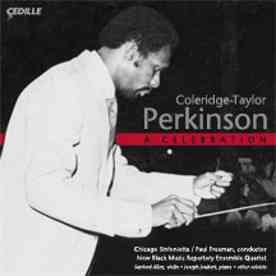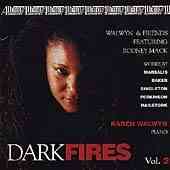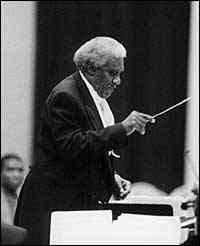Composers:
AfriClassical Blog
William J. Zick, Webmaster,
wzick@ameritech.net
©
Copyright 2006-2022
Coleridge-Taylor Perkinson (1932-2004):
African Heritage Symphonic series, Vol. III
Dark Fires 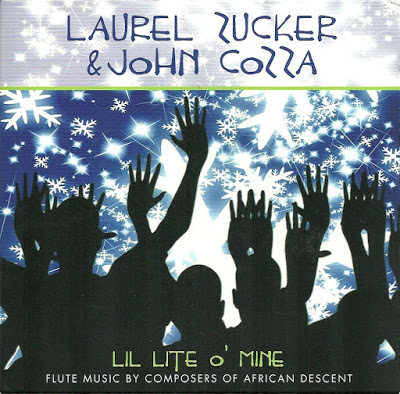
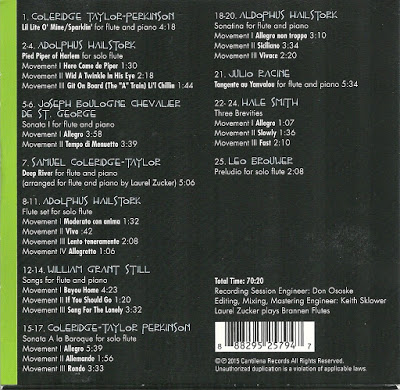
|
Home -> Composers -> Perkinson, Coleridge-Taylor
Audio Samples:
2 Youth
Perkinson's 1948 composition And Behold won the High School for Music and Art Choral Competition.
3
Music Education
4 Jazz
5 Conducting
6 Musical
Scores
Perkinson also wrote the themes for the
television shows Room 222 and Get Christie Love!
8 Death
9 A Celebration
11 Additional Recordings A child's grace, for medium voice & piano. Melville: Edward B. Marks, 1977 (Anthology of art songs by Black American composers, ed. by Willis Patterson, p15). Text: Robert Herrick. CD: Dina Cameryn Foy, soprano; Polly Brecht, piano. DCF Records (1996, Remembrance; African-American songs). CD: Richard Heard, tenor; Pamela Howland, piano. HM Classics (1998; Ain’t a that good news?). A short movement for treble instrument and piano (ca. 1952). New York: Tosci Music. A warm December, his love, her daughter, their story; something to remember, incidental television music for Verdon Productions and National General (1972). A woman called Moses, incidental television music, co-composed with Van McCoy (1978). ----- Voices, visions. Alla burletta, to my grandson (1996). Amazing grace, incidental film music for United Artists (1974).
And behold, for SATB (1948). Won: High School
for Music and Art Choral Competition. CD: Hamiett Bluiett, saxophone. Just 158-2 (2002, Bluiett blueback). Attitudes, for tenor, violin, violoncello & piano (1963). New York: Tosci Music. 1. Sinfonia; introduction [text: Coleridge-Taylor Perkinson]; 2. Ricercare I, on aloneness [text: Tu Fu, Lawrence Ferlingetti, e. e. cummings]; 3. Ricercare II,on death [text: Dyland Thomas, John Donne, Mei Tao Chen, Langston Hughes; 4. Ground, on love [text: John Drysen, Charles Cotton]; 5 Finale, on freedom [text: Langston Hughes, Thomas Paine, Margaret Walker, e. e. cummings; Boris Pasternak]. Commission: Ford Foundation (1962?), for George Shirley. Dedication: George Shirley. Première: 1964; New York; Metropolitan Museum of Art; George Shirley, tenor. B. S., for jazz quintet. Instrumentation: trumpet, guitar, 2 percussion & double bass LP: A&M Records SP-729.(1978) Barbara McNair show, incidental television music (2 seasons, 1970-1971). Bearden on Bearden, incidental music for television (1980). Nominated for an Emmy award, Outstanding Individual Achievement for Music in a Documentary (1985). Belafonte '73. LP: Blues, for violin (1990). Blue’s forms I, for violin & piano (1972). New York: Tosci Music; Melville: Belwin-Mills. 1. Plain blue/s; 2. Just blue/s; 3. Jettin’ blue/s. Dedication: Sanford Allen. Première:1972; New York, Carnegie Hall; Sanford Allen, violin. CD: Roger Zahab, violin; Robert Frankenberry, piano (2001/VIII/6). Blues forms II, for trumpet & orchestra. Boardwalk, incidental film music (1979). Brer soul. LP: Melvin van Peebles. Buked again. Première: 1994/V1; New York; Schomburg Center for Research in Black Culture. Burl’s tune, for flute & piano. LP: Antara DM 9633. Carmen, ballet (1973). Commission: Dance Theatre of Harlem. Centerfold murders, incidental television music. Ceremonies in dark old men, incidental television music for ABC Television (1974). New York: Tosci Music. Commentary; a concert piece in two parts based on Troubled waters and the provocation of the age-old quest for equality, or violoncello & orchestra (1964). NewYork: Tosci Music. 85p. Commission: National Association of Negro Musicians. Dedication: Kermit Moore. Instrumentation: 2222 cbsn, 4231, perc, piano, strings. Dedication: Kermit Moore. Première: 1967; New York; Kermit Moore, cello; Symphony of the New World; Benjamin Steinberg, conductor. Concerto, viola (1954). New York: Tosci Music. Graduate paper (M.M.) Manhattan School of Music, 1954. Dedication: Selwart Clarke. Première: 1964/VIII/11; National Association of Negro Musicians; Selwart Clark, viola; Orchestra of America; Coleridge-Taylor Perkinson, conductor. Concerto, violin. Concerto, violoncello. Crossroads Africa, incidental film music for the United States Information Agency (1962). New York: Tosci Music. Delinkwit deliquent lipeup; 3 eastside miniatures, for flute & piano (1990). Commission: Harold Jones. CD: Harold Jones, flute; Colette Valentine, piano. Leonarda LE 333 (1993, Let us break bread together). Dunbar, for medium voice, SATB & orchestra. Text: Countee Cullen, Paul Laurence Dunbar. Dedication: Paul Laurence Dunbar. 9 Elizabethan love lyrics, for low voice & piano(c1952). Melville: Edward B. Marks, 1977 (Anthology of art songs by Black American composers, ed. by Willis Patterson). 1. The faithless shepherd [text: Robert Herrick]; 2. A child's game [text: John Fletcher]; 3. Melancholy [text: John Fletcher]. LP: Gasparo GAS 287. ----- 3. Melancholy. AC: George Shirley, tenor; Christina Dahl, piano (1995/III/31, Lawrence University, Ben Holt Memorial Concert Series). CD: Odikhiren Amaize, bass-baritone; David Korevaar, piano. Musicians’ Showcase MS 1011 (2000; The Negro speaks of rivers; Art songs by African-American composers). Exercise; Dis go dis way, for jazz ensemble. LP: A&M Records SP-729.(1978) Fire, foment, ferment. LP: Leon Bibb. Forces of rhythm, ballet (1973). New York: Tosci Music. Commission: Dance Theatre of Harlem. For Bird, with love, ballet (1984). Commission: American Dance Theater Foundation for the Alvin Ailey American Dance Theater. Freedom Road, incidental film music (1979). Freedome-freedom, for SATB & chamber orchestra (1970). New York: Tosci Music, 1970. ----- for SATB & piano. Milwaukee: Hal Leonard, Frank Music Corporation, 1970 (T-101). 40p. ----- for SATB, electric bass, percussion & 2 pianos. From Montgomery to Memphis, incidental music for television. Get Christive Love, incidental television music. Gittin’ it good. CD: Hamiett Bluiett, saxophone. Just 158-2 (2002, Bluiett blueback). God is a (guess what)?, incidental music for the play by Ray McIver (1968). New York: Tosci Music. Grass; a poem, for piano, percussion & strings (1956). New York: Tosci Music, 1973. 35p. (#120006-21). After texts by Carl Sandburg. Happy birthday, Mrs. Craig, incidental film music for Harry Belafonte Enterprises (ca. 1971). Humpback/CD: Hamiett Bluiett, saxophone. Just 158-2 (2002, Bluiett blueback). If he hollers, let him go, incidental film music for Cinerama (1968). ----- So tired. LP: Tower S-5152. It's time. LP: Max Roach. J. T., incidental television music (1972). Lament, for viola & piano (c1955). ----- for flute & piano )1994). Lamentation for JJ; ballad for Babs. CD: Hamiett Bluiett, saxophone. Just 158-2 (2002, Bluiett blueback). Lamentations; Black folksong suite, for violoncello (1973). New York: Tosci Music. 1. Fuging tune; 2. Song form; 3. Calvary ostinato; 4. Perpetual motion. Première [partial]: 1973/VI/5; New York, Alice Tully Hall; Ronald Lipscomb, cello. ----- 1. Fuging tune. CD: Anthony Elliott, cello. Collins Classics 14542 (1996, Witness, vol. 3, Towards the future). Liner notes: Dominique-René de Lerma. ----- 2. Song form. Duration: 2:11. CD: Anthony Elliott, cello. Clarion CLR 906 CD (2004; The witness collection; Dance like the wind). Liner notes: Dominique-René de Lerma. CD: Anthony Elliott, cello. Collins Classics 14542 (1996, Witness, vol. 3, Towards the future). Liner notes: Dominique-René de Lerma. ----- 3. Calvary ostinato. CD: Michael Rudiakov, cello. Centaur 2192. ----- 4. Perpetual motion. Duration: 5:02. CD: Anthony Elliott, cello. Clarion CLR 906 CD (2004; The witness collection; Dance like the wind). Liner notes: Dominique-René de Lerma. CD: Anthony Elliott, cello. Collins Classics 14542 == or 14762? But not no. 1(1996, Witness, vol. 3, Towards the future). Liner notes: Dominique-René de Lerma. CD: Michael Rudiakov, cello. Centaur 2192. Lena Horne; the lady and her music, music for Brodway production. Like it is, incidental television music. Lost in the stars, incidental television music. Lou Rawls special, incidental television music for Winters-Rosen Production (1971). Love is not enough, incidental television music (1978). 13 Love songs in jazz settings, for voice & piano (c1968). New York: Tosci Music. 1. Blues with a tag; 2. Blues; 3. Ad lib + tune; 4. Riff, no. 1; 5. Riff, no. 2; 6. To be?; 7. Seventh song; 8. In 4; 9. Nack beat; 10/ Riff, no. 3; 11. Ballad; 12. Ad lib + changes; 13. Abstract blues. Malcachon, incidental music for the play by Derek Walcott (1969). New York: Tosci Music. Man better man, incidental music for the play by Erroll Hill (1969). New York: Tosci Music. McMillan and wife, incidental television music. Memphis to Mobile, incidental film music. Mercy, ballet (1986). Commission: Eleo Pomare Ballet Company. 3 Miniatures, for flute & piano. Duration: 7:57. CD: Harold Jones, flute; Colette Valentine, piano. Leonarda LE 333 (1993, Let us break bread together). Montgomery to Memphis, incidental film music. More today than yesterday. LP: Barbara McNair. New perspectives. LP: Donald Byrd. Nightside, incidental television music (1972). Mop/Mop, for orchestra. CD: Moravian Philharmonic Orchestra; Jiri Mikula, conductor. Vienna Modern Masters VMM 3045 (1998, New music for orchestra). New tune, for jazz ensemble. LP: A&M Records SP-729 (1978). Music mines, no. 1. NOT CLEAR==. 13 jazz-pop albums. 4 Bach Brandenburg 4 & 5. Nightside, incidental television music. Ode to Otis, ballet, for saxophone, electric guitar, electric bass, percussion, piano, violin & cello. New York: Tosci Music. Commission: Arthur Mitchell’s Dance Theater of Harlem. Première: 1971. Paul Draper on tap. LP: Coleridge-Taylor Perkinson, piano. Hoctor Records HLP 4031. Phoenix rising; birth, ballet (1987). Commission: Dance Theatre of Harlem. Première: 1987. Plantin’ time. n.p.: MMI Music. Psalm 23, for SSATB (ca. 1968). Psalm 100, for SSA, brass & strings (c1949). New York: Tosci Music. Première: 1951; New York, Town Hall; St. Cecelia Club; Hugh Ross, conductor. Quartet, strings, no. 1 "Calvary" (1951). New York: Tosci Music. Première: 1956. Riffs, romps, and stomps in the form of prelude, canon, and postlude, for 12 violas. Room 222, incidental television music for Twentieth-Century Fox, ABC Television. Scherzo, piano (1952). New York: Tosci Music. Première: 1976. CD: William Chapman Nyaho, piano (2003/VIII/03/03; Churchill College, University of Cambridge). Seasons, for jazz ensemble. LP: A&M Records SP-729.(1978) Sinfonietta, no. 1, for strng orchestra (1953). New York: Tosci Music. 37p. 1. Allegro [4:00]; 2. Largo [5:00]; 3. Allegro furioso [7:00]. Duration: 16:00. Première: 1966; Hilversum; Radio Kammerorchester. Sinfonietta, no. 2, “Generations” (1996,). New York: Tosci Music, 1998. 1. Misterioso – allegro; 2. Alla sarbande; 3. Alla burletta; 4. Allegro vivace. Commission: Michel Rudiakov and the Manchester Music Festival, Vermont. Première: 1996. Duration: 19:31. CD: Chicago Sinfonietta; Paul Freeman, conductor. Cedille CDR 90000 066 (2002; African heritage symphonic series, v3). Liner notes: Dominique-René de Lerma. Smile, co-composed with Paul Simon. LP: Warner Brothers 2957-2. Sonata, flute & piano. 1, Andante; Allegro;Meno mosso; 2. Slowly; 3. Rondo. CD: Laura Falzon, flute; Mark Ray, piano (2003/VIII/02; Churchill College; University of Cambridge). Sonata, piano, no. 1 (ca. 1965). New York: Tosci Music. Contents: 3 movements. Based on Didn't my Lord deliver Daniel?. Sonata, piano, no. 2 .”Statements” (1975). New York: Belwin-Mills, 1977. Commission: Bicentennial Commission of the Washington Performing Arts Society. Première: 1979. 1. Sonata-allegro; 2. Theme and 8 variations, based on Another man don’ gone; 3,Rondo. Duration: 17:01. CD: Anthony Padilla, piano. CRI CD 823 (1999; A la par). Liner notes: Dominique-René de Lerma and Robert Schwarz. 18p. CD: Karen Walwyn & Friends. Albany TROY 384 (2000, Dark fires, vol. 2). Sonata à la Baroque, for flute & piano (1994). New York: Tosci Music, 1998. Sonatina, percussion (ca. 1965). New York: Tosci Music. 1. Canons; 2. Song form; 3. Fugue. Song of the Lusitanian bogey, incidental music to the play by Peter Weiss (1967), for the Negro Ensemble Company. 3 Songs of Robert Hillyer, for voice & piano (ca. 1952). New York: Tosci Music. 1. Serenade; 2. Madrigal; 3. Lullaby. Première: ca. 1952. Songs to spring, for voice & piano (c1968). New York Tosci Music. Splendid mummer, incidental music for the play by Lonnie Elder. Première: St. Louis. Spiritual fantasy on Calvary, for flute & piano (1993). Symphony of the Sphinx, for soprano, SATB &orchestra 1. The gathering; 2. The query; 3. Finale, the affirmation. Commission: ASCAP and the Texaco-Sphnx Competition. Text: Ego-tripping, by Nikki Giovanni (1970), Heritage, by Countee Cullen (1925). Première: 2002/II/11; Detroit, Orchestra Hall; Brenda Wimberly, soprano; The Brazeal Dennard Chorale, Our Own Thing Chorale, Sphinx Competition Orchestra; Leslie B. Dunner, conductor. Talk to me, incidental film music (1982). The Christ child, for SATB [?==] (1949). Première: 1949. The education of Sonny Carson, incidental film music for Paramount Pictures (1974). 1. Where do I go from here?; 2. The robbery anmd the chace; 3. Exercise run; 4. Girl, girl, girl; 5. Daydreams; 6. The rumble; 7. Funeral; 8. Funeral parlor; 8. Please be there; 9. Flashbulbs; 10. Father and son; 11. The junkies; 13. A new direction; 14. End title. CD: Paramount PAS 1045. The Emperor Jones, incidental theater music. Commission: Pepsico Festival. The great MacDaddy, incidental music for the play by Paul Carter Harrison (1974). New York: Tosci Music. Première: 1974/XII/1. The legacy, for narrator, voice, chorus & orchestra (1982). The McMasters, tougher than the West itself; the blood crowd, incidental film music for Jayjean Productions (1969). The touch of time. LP: Tamla/Motown M 1087 (1965). Thomasine and Bushrod, incidental film music for Columbia Pictures, Warner Brothers (1974). To Damascus, incidental music to the play by August Strindberg (1960). Toccata, piano, C major (1953). Melville: Belwin-Mills, 1973. Dedication: Samuel DilworthLeslie. Première: 1975/VIII/6; Washington, National Gallery of Art, James Pettis, piano. Duration: 2:26. CD: Michael Kim, piano. CRI CD 823 (1999; A la par). Liner notes: Dominique-René de Lerma and Robert Schwarz. 18p. CD: William Chapman Nyaho, piano. Musicians Showcase MS-1091 (2003, Senku; Piano music by composers of African descent). Liner notes: Maya Amgelou, William Chapman Nyaho. Together for days, incidental film music for Independent Productions (1972). Troubled waters, for SATB & jazz band. Written for Max Roach. Up, up, up. LP: Donald Byrd. 6 Variants on a Black folk tune, for flute & piano (1993). Commission: Harold Jones. CD: Ankara DM 9633. Variations and fugue on The ash Grove, for violin & piano (early 1950s). New York: Tosci Music. Vever, ballet (1984). We’re family fittin’ in, incidental television music. You’re gonna love my baby, co-composed with Ronald Miller and Barbara McNair. LP: Tamla/Motown M 1087. Zippin’
CD: Hamiett Bluiett, saxophone. Just 158-2 (2002,
Bluiett blueback).
13 Bibliography “Concerto for viola, no. 1; New York” in Music journal, v22 (1964/X) p65. “Concerto for viola, no. 1; Orchestra of America” in Musical America, v84 (1964/IX) p44-45. “New Black Music Repertory Ensemble” in CBMR digest, v15n1 (2002/spring) p7,15. Abdul-Rahim, Raoul. “Spotlight on Black composers” in Blacks in classical music. New York: Dodd, Mead, 1977, p57-59. Abdul-Rahim, Raoul. Blacks in classical music; A personal history. New York: Dodd, Mead, 1977. ASCAP biographical dictionary, 4th ed. New York: Jacques Cattell, 1980. Baker, David. The Black composer speaks, by David Baker, Lida Belt, and Herman Hudson. Metuchen: Scarecrwo Press, 1978. Banfield, William C. Landscapes in color; Conversations with Black American composers. Landham MD.: Scarecrow Press, 2003. xvi, 380p. ISBN 0-8108-3706-4. Berry, Lemuel, Jr. Biographical dictionary of Black musicians and music educators, vol. 1. Guthrie OK: Educational Book Publishers, 1978. Black music research journal, 1980, p5; 1981-2, p46 Black perspective in music, v3n1, p123; v3n3, [310, 318, 347; v5n2, p239, 237; v6n2, p239; v14n1, p38, 47, 57, 59, 72, 82 Bogle 1989, p114 Breda, Malcolm J. “Perkinaon, Coleridge-Taylor” in International dictionary of Black composers, ed. by Samuel A. Floyd, Jr. Chicago: Fitzroy Dearborn, 1999, v2, p905-913. Brooks, Tilford. America’s Black musical heritage. Englewood Cliffs: Prentice-Hall, 1984. Bull 1974, Bull, Storm. Index to biographies of contemporary composers, vol. 3. Metuchen: Scarecrow Press, 1987. xxiv, 854p. ISBN 0-8108-1930-9. Carter, Madison H. An annotated catalogue of composers of African ancestry. New York: Vantage Press, 1986. Chism, Olin. “Diversity shows in symphony and gospel chorus combination” in Dallas times herald (1977/V/12). Claghorn, Charles Eugene. Biographical dictionary of American music. West Nyack NY: Parker Publishing, 1973. Gelormine, Phil. “Review, Mandrill’Symmphony of thje New World” in Billboard (1973/II/24). Handy 1995 Handy, D. Antoinette. Black music; Opinions and reviews. Ettrick VA: BM&M, 1974, p18 Harris, Steve. Film, television, and stage music on phonography; A discography. Jefferson NC: McFarland, 1988. Hoffman, Gilda. Rave notes” in Overtones [High School for Music and Art] (1949/spring. Horne, Aaron. Brass music of Black composers; A bibliography. Foreword by David N. Baker. Estport: Greenwood Press, 19 Horne, Aaron. String music by Black American composers. Westport: Greenwood Press, 1991 (Music reference collection, no. 33). xx, 327p. Foreword by Dominique-René de Lerma. ISBN 0-313-27938-1. J. B. “Memorial to H. T. Burleigh, composer, is presented at Carnegie Recital Hall” in New York times (1956/XI/4). Lerma, Dominique-René de. Minnesota Black Composers Seminar, May 18-24, 1975, presented by the Afro-American MusicOpportunities Association. n.p.: n.p., 1975. 20p. Lerma, Dominique-René de. Symposium of symphonic music by Black composers, Houston, September 3-7, 1974. n.p.: n.p., 1974. 24p. Mapp, Edward. Directory of Blacks in the performing arts. Metuchen: Scarecrow Press, 1978.; 1990 Moore, Carman Leroy. “Perkinson, Coleridge-Taylor” in The new Grove dictionary of American music, ed. by H. Wiley Hitchcock and Stanley Sadie. London: Macmillan, 1986, v3p536. Patterson 1988, p239, 320, 616 Roach, Hildred. Black American music, past and present. Miami: Krieger Publishing, 1985, v1. Salem 1991 Southern, Eileen. “Perkinson, Coleridge Taylor” in Biographical dictionary of Afro-American and African musicians. Westport: Greenwood Press, 1982, p303. (The Greenwood encyclopedia of Black music). Spradling, Mary Mace. In black and white; Afro-Americans in print. 3rd ed. Detroit: Gale Research, 1980. Stow, Betsy, ed. 2nd International Symposium and Festival on Composition in Africa and the Diapora, including Dialogue – Africa meets Asia. Cambridge UK: Churchill College, 2003. 107p. Thomas 1989, p29 Vann, Kimberly R. Black Music in Ebony: An annotated guide to the articles on music in Ebony Magazine, 1945-1985. Chicago: Center for Black Music Research, Columbia College. 1990 (CBMR Monographs, no. 2)., p44 White, Evelyn Davidson. Choral music by Afro-American composers; A selected, annotated bibliography. 2nd ed. Metuchen: Scarecrow Press, 1996. viii, 126p. ISBN 0-8108-3037-X. First edition issued by Scarecrow in 1981: Who's who classical 1983, 1985. Woodward, Josef. “Black ensemble achieves goal” in Los Angeles times (1996/II/14)
This page was last updated on March 5, 2022 |
|||||||||||||||

